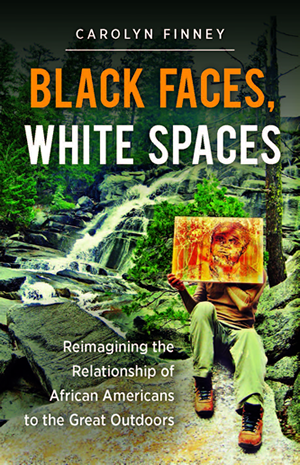In the case of race and the environment, it’s not just who we imagine has something valuable to say. These assumptions, beliefs, and perceptions can be found in the very foundation of our environmental thinking, how we define the “environment” and how we think of ourselves in relationship with the environment. Who do we see, what do we see?"
— from the Preface
Black Faces, White Spaces
Why are African Americans so underrepresented when it comes to interest in nature, outdoor recreation, and environmentalism? In this thought-provoking study, Carolyn Finney looks beyond the discourse of the environmental justice movement to examine how the natural environment has been understood, commodified, and represented by both white and black Americans.
Bridging the fields of environmental history, cultural studies, critical race studies, and geography, Finney argues that the legacies of slavery, Jim Crow, and racial violence have shaped cultural understandings of the "great outdoors" and determined who should and can have access to natural spaces.Drawing on a variety of sources from film, literature, and popular culture, and analyzing different historical moments, including the establishment of the Wilderness Act in 1964 and the aftermath of Hurricane Katrina, Finney reveals the perceived and real ways in which nature and the environment are racialized in America. Looking toward the future, she also highlights the work of African Americans who are opening doors to greater participation in environmental and conservation concerns.
Nik Heynen, University of Georgia —
"A wonderfully written and deeply insightful book that convincingly explodes the one-size-fits-all narrative of how nature in the United States is both often imagined to be racialized and is, in fact, racialized. Given the white privileging of geography, the sorts of intellectual-cultural insights offered here could very well be transformative. This book will stand alone in the field of geographic treatments of race and nature."
Julian Agyeman, Tufts University —
"Using collective memory, race, and environment, Finney looks at the effect of slavery and Jim Crow segregation and their key roles in shaping African American connections to place--the 'great outdoors' or the 'environment' more generally. She looks at representation of African Americans in the great outdoors as being a key site of contestation, of struggle. She also looks at the difficulties inherent in discussions of race and diversity within environmentalism, and with environmentalists. Finney shines a different light, and brings a different voice to bear."
ANTHOLOGIES
“Joy is a Revelation”
in Nature Swagger: Stories and Visions of Black Joy in the Outdoors, edited by Rue Mapp, Chronicle Books
“Memory Divine”
in A Darker Wilderness: Black Nature Writing from Soil to Stars, edited by Erin Sharkey, Milkweed Press
